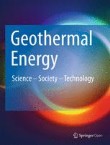Associated Societies
Monitoring cold water injections for reservoir characterization using a permanent fiber optic installation in a geothermal production well in the Southern German Molasse Basin
Fiber optic sensing has gained importance for wellbore monitoring and reservoir characterization in geothermal fields as it allows continuous, spatially highly resolved measurements. Distributed acoustic sensi...
